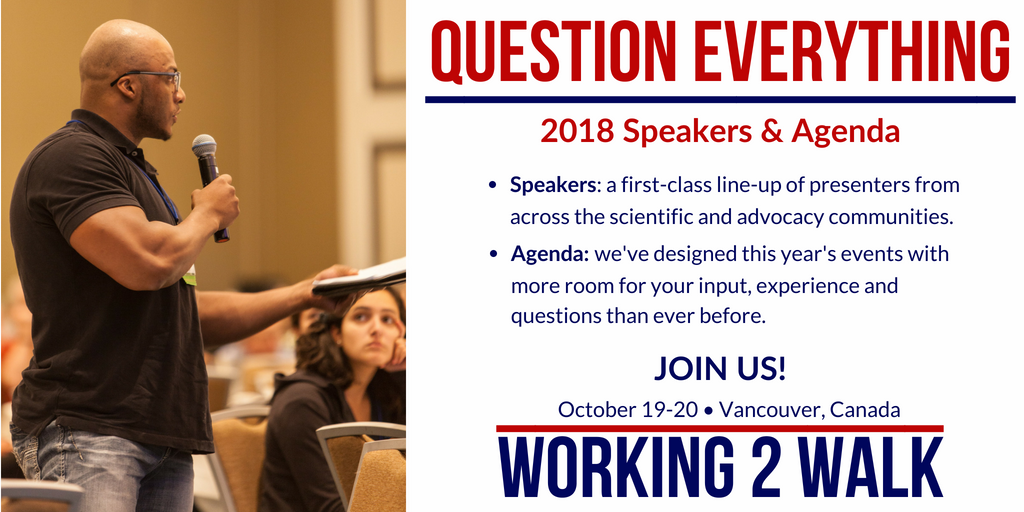
Way back in my previous life as a manager in an Emergency Department, I used to attend ER and Healthcare conferences on a fairly regular basis. It didn’t take too many conferences to realize that they’re all pretty much the same. The colors, the columns and the chandeliers are different (though not that much, really) from hotel to hotel, but the conferences all felt similar.
We’ve been talking for a few years about how we don’t want Working 2 Walk to be like that, or end up like that: a rotating cast of characters having the same conversations over and over, peppered by one or two flashy presentations. It's one thing to have a conference circuit that’s peddling the newest designs in stretchers and care delivery, or ‘secrets to reducing your Length of Stay' like I used to sit through back then. It's quite another to be doing this in service of expediting Cures for SCI.
That’s why we're working to design this year’s conference a bit differently: to be organized around opportunities for your direct input. Yes, there will be the same colors, columns and chandeliers. But we want to get beyond the ‘gee-whiz’ portrayals of the science and balance the ‘see what I did in my lab’ presentations with some more critical engagement.
A guiding principle that has shaped the development of this year’s agenda is the following maxim: Context, Strategy, Voice. Here's what it means:
Context: the SCI Community must understand the broader context within which the scientific and clinical enterprise is operating. Without context, our community is left swimming in a sea of press releases, donation requests and ambitious and sometimes misleading promises. Relatedly, the Research Enterprise must understand the broader context of the lived experience with SCI so that the targets being sought match our Community’s priorities.
Strategy: once we have a better and more realistic understanding of the context, we can then make intelligent and factually based decisions on strategic initiatives. How and in what areas do we place our people resources, our dollars and our efforts to insure that we arrive at our goal of realizing cures? But also, how do we insure that cures are made available to all across the planet and how do we insure that cures are optimized for all?
Voice: It is only with a good understanding of the context that we can develop realistic and effective strategies that build an effective chorus of voices from amongst the community and our various stakeholders. And it is with that effective and collective voice that we can demand the cures we seek.
Using this model to guide the agenda we have created 4 Sections (2 on each day) that will represent a significant increase the amount of time dedicated to directed discussions from all conferees around a contextualized depiction of the various scientific strategies to move the science to clinical relevance, the economic factors and incentive structures which frame those scientific and clinical strategies and where the SCI community can have an impact.
The moderated and facilitated conversations will be around these topics:
Spinal Stimulation: how it's being validated, what is being targeted, how it's being measured, and can it all be done less expensively and thereby faster? (This subject will be touched on in various ways by Andrei Krossioukov, David Magnuson and Megan Gill as well as in a panel discussion moderated by Lyn Jakeman)
Basic and Translational Research / Acute and Chronic Studies: Where are we, what do we know (and what don't we know), what are the incentive structures influencing various lines of research, what are the funding conventions that need to be challenged? (This subject will be touched on in various ways by Brian Kwon, Wolfram Tetzlaff, Jan Eric Ahlfors as well as in a panel discussion moderated by Lyn Jakeman)
Bowel Bladder Sexual Function: There are some available interventions being trialed and its great to see research responding to our critical priorities. At the same time why is there so little research being conducted on the whole BBS body system? And more specifically why is there even less research focused on sexual function? Especially when these functions are top priorities for people living with SCI? (This subject will be touched on in various ways by Dennis Bourbeau, Justin Brown and Stacey Eliliot as well as in a panel discussion moderated by Tracey Wheeler)
Rehab and Exercise Based Therapies: are the only current treatment options. Some scientific discoveries are suggestive of various forms of disruption to promote recovery, where and how are these discoveries being tested and translated? What can the SCI community do to create much needed capacity for rehab and exercise? (This subject will be touched on in various ways by Karim Fouad, Tommy Sutor, Dale Hull as well as in a panel discussion)
And lastly, we are dispensing with our traditional breakout sessions at the end of the second day in favor of a pointed, open discussion with all conferees around practical, specific and actionable steps we can take to address some of the questions raised above. This conversation will have a particular focus on what the SCI Community can do to have an impact in a number of areas (e.g. public policy, research enterprise points of entry, and other advocacy opportunities).
Join us!

















